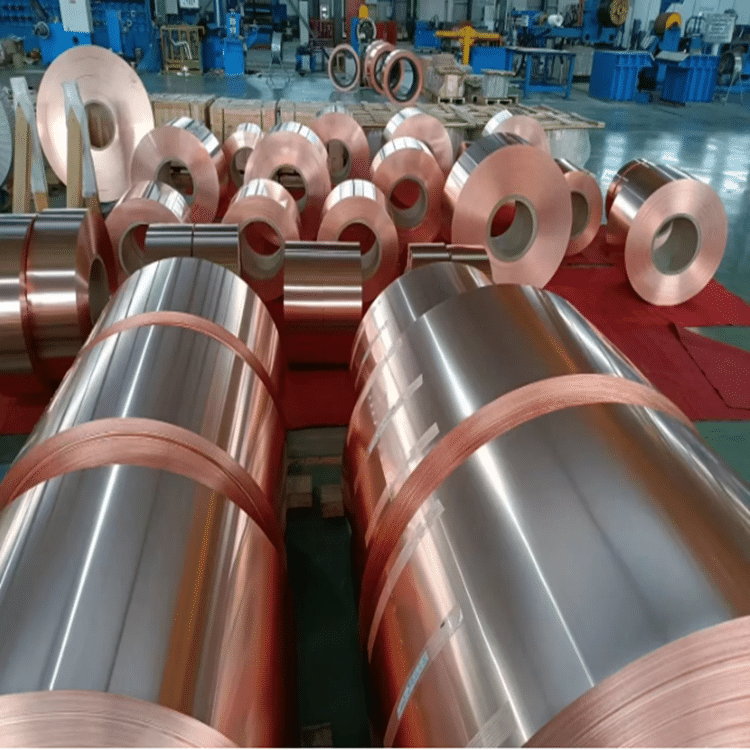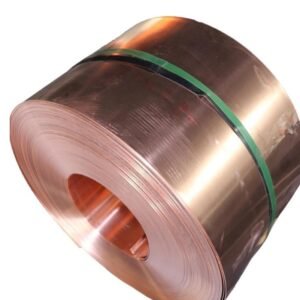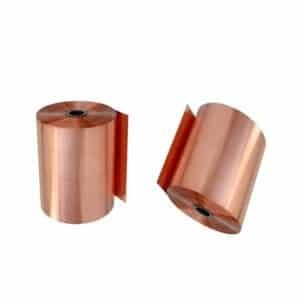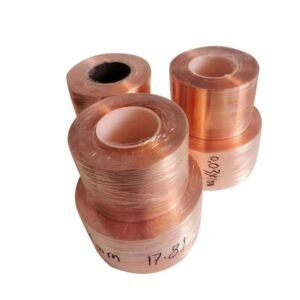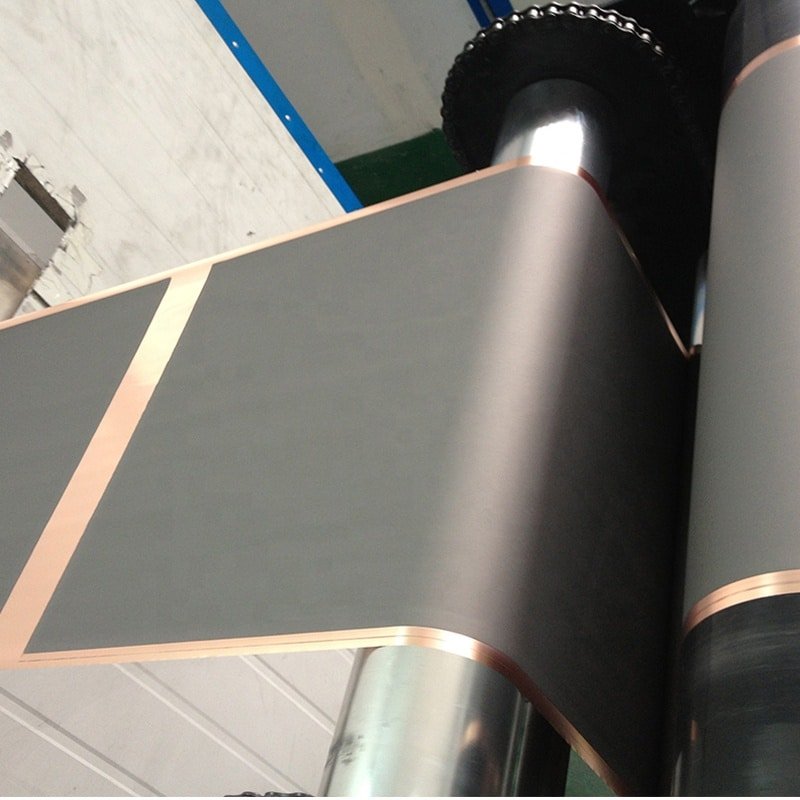Introduction to Copper Foil
When we think of cutting-edge battery technology, our minds may drift towards sleek designs, long-term power output, and innovative materials – but behind all the buzz surrounding lithium-ion batteries and other innovations lies one unsung hero that often goes unrecognized: copper foil.
Yes, that’s right! Copper foil plays an integral part in pushing battery performance to new limits. From powering electric vehicles to revolutionizing renewable energy storage systems, copper foil has quietly changed how we access and store energy.
In this blog post, we’ll investigate copper foil’s current application to battery technology as well as its future potential to impact energy storage solutions. Join us as we journey into an exciting world where thin sheets of copper are making big waves!
Copper Foil Applications in Battery Technology
Copper foil plays an integral part in modern battery technology. Due to its conductivity and durability, copper foil makes an excellent material choice for use in lithium-ion batteries that are commonly found in portable electronics devices, electric vehicles, and renewable energy storage systems. Copper foil current collectors are used in such batteries.
Copper foils serve as the basis of electrode fabrication in lithium-ion batteries, creating an accessible surface where active materials such as graphite or lithium cobalt oxide can be deposited onto for creating stable electrical connections within each battery cell and enabling efficient charge/discharge cycles.
Copper foil thickness must strike an equilibrium between electrical conductivity and mechanical strength, to promote flexibility while at the same time offering increased durability. Thanks to cutting-edge manufacturing technologies, ultra-thin copper foils with enhanced properties are now produced that can further optimize battery performance.
Copper foil provides another useful benefit by acting as a barrier layer between electrodes and electrolytes, helping prevent unwanted reactions at their interface and thus increasing overall system stability and safety.
As demand for high-performance batteries continues to increase, researchers are seeking ways to enhance current technologies while prioritizing sustainability and cost effectiveness. Traditional battery materials present limitations which drive innovation towards next-generation solutions.
One such advancement is the advent of solid-state batteries, in which copper foil plays an instrumental role once more. Solid-state batteries replace liquid electrolytes with solid alternatives that offer higher energy density and increased safety compared to conventional designs.
Copper foils facilitate electron transport within solid-state batteries by creating low resistance paths across both positive (cathode) and negative (anode) electrodes layers, typically comprised of active materials like sulfides or oxides sandwiched between thin layers of solid electrolyte.
Use of copper foil current collectors will enable batteries designed for future uses such as wearable devices or grid-scale energy storage systems to achieve increased energy efficiency, longer cycle life and greater safety.
Limitations and Challenges of Traditional Battery Materials
Traditional battery materials, such as lithium-ion batteries, have long been utilized by various industries; however, these batteries present their own set of challenges that limit their performance and efficiency.
One major drawback of traditional battery materials is their limited energy density, meaning that even with advancements in technology they can only store so much power at any given time, limiting overall capacity and prompting devices powered by these batteries to require frequent charging or have shorter operating lives.
Another issue lies with traditional battery materials’ slow charging speeds; fully charging a lithium-ion battery may take hours, which can be inconvenient for users who rely on them throughout their day. Furthermore, rapid charging may overheat and shorten their lifespan.
Traditional battery materials tend to degrade over time due to repeated cycling between charging and discharging cycles, leading to wear-and-tear damage on electrodes and electrolyte components resulting in reduced capacity retention and overall performance degradation over time.
As well as these limitations, traditional battery materials also pose environmental concerns. Many traditional rechargeable batteries contain toxic elements like lead and cadmium which pose risks to human health if improperly disposed of.
Copper foil stands out as an appealing material due to its unique properties and advantages, providing more sustainable solutions for our power needs. Copper foil batteries offer promising solutions.
Addressing some key weaknesses found in traditional materials like lithium-ion batteries by creating copper foil-based designs could transform how we power the world moving forward.
Advancements in Next-Generation Battery Technology
As our world evolves, so too has our demand for efficient and sustainable energy storage solutions. This has led to significant advancements in battery technology – with researchers and scientists continuously exploring new materials and designs that exceed traditional battery limitations.
One area of emphasis in this field is the creation of high-performance lithium-ion batteries. While they have revolutionized portable electronics, lithium-ion batteries still present challenges such as limited capacity, slow charging times and safety concerns. To address these concerns, researchers are searching for new electrode materials which will improve energy storage capacities while remaining stable.
Graphene-based electrodes offer great promise in this regard. Graphene is a single layer of carbon atoms arranged hexagonally lattice structure and boasts impressive electrical conductivity and mechanical strength, making it an excellent candidate for improving battery performance. Researchers aim to integrate graphene into battery electrodes in order to increase energy density, decrease charging times, and enhance overall efficiency.
Solid-state batteries offer another exciting advancement in battery technology. Traditional lithium-ion batteries use liquid electrolytes that may become flammable under certain circumstances, whereas solid-state batteries replace these volatile liquids with solid electrolytes which provide increased safety without compromising performance or energy density. Furthermore, solid state batteries offer higher energy densities when compared with their liquid counterparts.
Next-generation battery technology also looks at alternatives beyond lithium-ion chemistry – such as sodium or magnesium-based systems – which could offer greater benefits such as lower costs and greater availability of raw materials.
Technological advances continue to push the limits of what was thought possible with conventional battery technology! We can look forward to more efficient energy storage solutions that will power devices for longer than ever before! Stay tuned – more innovations await us on the horizon!
Copper Foil in Optimizing Battery Performance
Copper foil plays an integral role in improving battery performance thanks to its distinctive properties and characteristics. Copper’s excellent electrical conductivity enables efficient electron flow within batteries for improved power output and overall performance.
Copper foil offers excellent thermal dissipation capabilities in addition to its conductivity, helping regulate battery temperature by dissipating excess heat from within and maintaining ideal operating conditions for an optimum charge cycle. By maintaining stable temperatures within batteries, copper foil ensures enhanced safety and lifespan of batteries.
Copper foil also exhibits superior corrosion resistance, making it particularly suitable for use in batteries that often contain electrolytes that contain harmful corrosives that degrade other materials over time. Copper foil’s superior corrosion protection helps safeguard its integrity and ensure long-term reliability of battery operation.
Copper foil is highly flexible and bends easily without losing its conductivity properties, making it the ideal material choice for various battery designs that demand flexibility or compact designs.
Copper foil batteries enable manufacturers to significantly improve performance metrics like energy density, power delivery efficiency, thermal management capabilities and durability while meeting safety standards. As new-generation batteries emerge across industries such as electric vehicles and renewable energy storage systems, copper foil will continue to play an integral part in shaping our future energy landscape.
Potential Applications for Copper Foil Batterie
Copper foil batteries hold great potential to revolutionize various industries and pave the way towards a more eco-friendly future. Thanks to their superior performance and durability, these batteries can be applied across a range of applications.
Copper foil batteries could make an incredible impactful statement when applied to electric vehicles (EVs). As demand for these cars continues to surge, there is an increasing need for high-performance batteries with long driving ranges and faster charging times; copper foil batteries with their superior energy density and conductivity meet these criteria easily and make EVs more practical and energy-efficient.
Copper foil batteries offer another promising use for renewable energy storage. As we strive toward developing clean and green sources of power, storing excess renewable power becomes critical – copper foil batteries provide an efficient means of doing just this, keeping this surplus energy available even during times of low generation or increased demand.
Copper foil battery technology holds great promise in portable electronic devices like smartphones, tablets and laptops. Such devices need powerful yet compact battery solutions that offer long-term performance without compromising safety – copper foil batteries enable smaller form factors while offering greater capacity and stability.
Copper foil battery technology advancements could prove immensely valuable to the aerospace industry. With space exploration becoming ever more crucial, lightweight yet resilient power sources are indispensable to satellite and spacecraft missions; copper foil offers excellent thermal management properties as well as excellent electrical conductivity suitable for operating in extreme temperatures.
Copper foil batteries can bring considerable advantages to grid-scale energy storage systems. Such storage units play a pivotal role in stabilizing electricity grids by balancing supply-demand imbalances; with copper-based battery technologies implemented into their design, grid storage systems could store large amounts generated during off-peak hours that can later be utilized when demand exceeds supply.
Copper foil batteries hold great promise across various industries, from automotive and renewable energy through consumer electronics and aerospace. Their superior performance characteristics suggest they could revolutionize many sectors.
Conclusion: Copper Foil as the Future of Battery Technology
As we consider the future of battery technology, copper foil will surely play a vital role in driving innovation and improving performance. Boasting superb electrical conductivity, durability, and cost-effectiveness features that make copper foil an indispensable component in next-generation batteries.
Researchers and industry professionals are continually exploring new methods for increasing battery efficiency and capacity. Copper foil has already shown its worth in various applications such as lithium-ion batteries for electric vehicles and renewable energy storage systems, boasting improved electrode stability, reduced internal resistance, and increased energy density – qualities which make it a formidable candidate for developing advanced batteries.
Nanotechnology advancements have opened up exciting new options for using copper foils with enhanced properties. Surface modifications at the nanoscale level can further optimize current distribution within electrodes, leading to faster charging/discharging rates and overall battery performance enhancements.
Copper foil offers environmental advantages beyond improving battery performance, making it a key material in sustainable practices across industries. Copper’s recyclable properties ensure valuable resources are conserved while simultaneously decreasing waste generation.
Looking forward, we can expect ongoing research on optimizing copper foil production techniques and exploring novel applications across a range of batteries – from consumer electronics to grid-scale energy storage solutions. Furthermore, collaborations between academic researchers and industrial ones will foster knowledge sharing and accelerate advances in this field.
Existing challenges on the path towards wide adoption of copper foil-based batteries include issues related to scaleability and cost constraints; ongoing efforts hold great promise of surmounting them.
Copper foil promises a bright future in shaping our energy landscape through more efficient and eco-friendly battery technologies. Through continuous innovations that bring forth new opportunities while addressing current limitations head-on, we can anticipate a world in which reliable power sources ensure a sustainable future for generations yet unborn.

